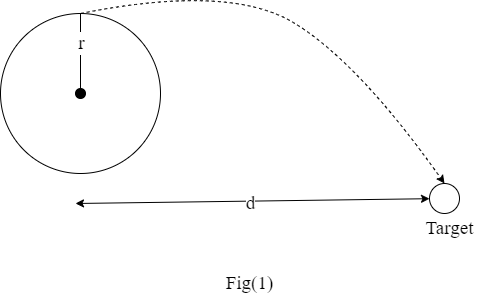You plan to throw stones by using a sling that you whirl over your head. You will whirl the stone in a horizontal circle with a radius of 1.5 m at a height of 2.9 m above the ground (this is often referred to as a "conical pendulum", which you saw a picture of in the necklace part of the 3-1 studio).
You want the stone to hit a target on the ground a distance of 16.5 m in front of you and 1.5 m to the side (note that this number is the same as the radius of the circle). This means that the stone is released a distance 1.5 m to the side of you, but then travels a distance 16.5 m forward.
What must be the magnitude of the centripetal acceleration of the stone just before you release it?
When the stone is released it follows a trajectory similar to that of a projectile launched from a height.

Consider the vertical velocity. When the stone is released the horizontal component will not face any resistance but the vertical velocity will be affected by the force of gravity acting on the stone.
Also, the total vertical distance traveled will be the same as the height from which it was launched.
Thus we can write,
Now initially there will be no vertical velocity, and hy will be h thus the equation reduces into,
Also, horizontal velocity will remain constant and can be found out using the equation,
Once the velocity is found out we can calculate the acceleration using the formula,
Trending nowThis is a popular solution!
Step by stepSolved in 5 steps with 1 images

- At amusement parks, there is a popular ride where the floor of a rotating cylindrical room falls away, leaving the backs of the riders “plastered” against the wall. Suppose the radius of the room is 7.9 m and the coefficient of friction between the rider and the wall is 0.839, what is the minimum the safe speed of the wall for the rider not to drop when the floor falls away. Use g=9.8 m/s2.arrow_forwarddegrees Question 8. A wrecking ball swings at the end of a 11.2-m cable on a vertical circular arc. The crane operator manages to give the ball a speed of 10.1 m/s as the ball passes through the lowest point of its swing and then gives the ball no further assistance. Friction and air resistance are negligible. What speed vf does the ball have when the cable makes an angle of 21.8° with respect to the vertical? Ans: 9.29 m/s the foctort accelerating animals, for it can go from rest toarrow_forwardA box descends a ramp and lands on a surface. The box exits the side of the table as it meets the bottom of the tamp, becoming a horizontal projectile. It lands x metres away from the table. The same ramp may be rolled down by a solid sphere with the same coefficient of friction, mass, and height. Will the sphere land a long way away? fewer than a lot more At a similar size B. Have a paragraph-length description of the logic.arrow_forward
- An object with mass M slides across a frictionless half-circular slide of radius R. The object is initially held stationary at the top of the slide. The initial height is, hi = R. The mass is released and slides down, around the bottom, and back up the other side. The radius of the slide is R = 5.79 m and the mass of the object is M = 37 kg. When the object is moving up the slide, at an angle θ = 18o from the vertical, what is the normal force on the object?arrow_forwardA bead is released at the top of a long ramp, slides down to the bottom and ascends a vertical loop of radius R on the inside. It must have enough speed to complete the loop, but just barely. Using energy and centripetal force, find the height of the ramp H compared to the radius of the loop, R. (Hint: You could assume a mass for the bead as well as a translational speed for the bead at the top of the loop. These are “straw quantities” which will disappear as you work out the problem.) This bead is sliding, not rolling, and all surfaces are assumed frictionless.arrow_forward